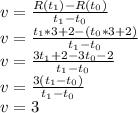
Physics, 17.09.2019 00:00, thomasbarbusca15
Problem 1.42 recall from , that robbie's position function is r ( t ) = t 3 + 2. what is robbie's average velocity from time t = 3 till time t = 4 ? what is robbie's average velocity from time t = 3 till time t = 3.5 ? what is robbie's average velocity from time t = 3 till time t = 3.1 ? what is robbie's instantaneous velocity at time t=3?

Answers: 1
Other questions on the subject: Physics

Physics, 22.06.2019 00:30, powberier6979
Consider an ordinary, helium-filled party balloon with a volume of 2.2 ft3. the lifting force on the balloon due to the outside air is the net resultant of the pressure distribution exerted on the exterior surface of the balloon. using this fact, we can derive archimedes’ principle, namely that the upward force on the balloon is equal to the weight of the air displaced by the balloon. assuming that the balloon is at sea level, where the air density is 0.002377 slug/ft3, calculate the maximum weight that can be lifted by the balloon. note: the molecular weight of air is 28.8 and that of helium is 4.
Answers: 2

Physics, 22.06.2019 02:10, kernlife
Astudent is performing an experiment comparing sound and light waves. the student gathers the following data. what conclusion does the student most likely make based on this data? light waves always travel the same speed; however, the speed of sound is determined by the medium that it travels through. all sound waves always have the same energy, so the temperature of the medium does not affect wave speed. light needs to vibrate particles, so it travels fastest in tightly packed solids, while sound does not need a medium, so it travels fastest in a gas. tightly packed particles in solids slow down the light waves; however, sound waves make particles bounce into each other, so they travel faster in solids.
Answers: 3

Physics, 22.06.2019 08:30, kmwise19
If an astronaut takes an object to the moon the following is true (choose only one). a the mass will change but the weight will be the same. b both the mass and the weight of the object will be the same. c the weight will change but the mass will be the same. d both the mass and the weight of the object will change.
Answers: 1

Physics, 22.06.2019 10:10, xavierfox1721
In a simplified model of the human eye, the aqueous and vitreous humors and the lens all have a refractive index of 1.40, and all the refraction occurs at the cornea, whose vertex is 2.60 cm from the retina. what should be the radius of curvature of the cornea such that the image of an object 40.0 cm from the cornea’s vertex is focused on the retina?
Answers: 1
Do you know the correct answer?
Problem 1.42 recall from , that robbie's position function is r ( t ) = t 3 + 2. what is robbie's av...
Questions in other subjects:



History, 09.07.2019 10:00

Mathematics, 09.07.2019 10:00


English, 09.07.2019 10:00

Spanish, 09.07.2019 10:00

English, 09.07.2019 10:00

Mathematics, 09.07.2019 10:00

History, 09.07.2019 10:00






 .
.





 . We can see that it's the equation of a line. That is, if we were to graph the position R against the time t, we would get a line.
. We can see that it's the equation of a line. That is, if we were to graph the position R against the time t, we would get a line. as the starting moment and
as the starting moment and  as the end moment measure the distance travelled. The distance travelled from instant 0 to instant 1 would the be
as the end moment measure the distance travelled. The distance travelled from instant 0 to instant 1 would the be  and the time spend in that time would be
and the time spend in that time would be  . So the velocity v is:
. So the velocity v is:




